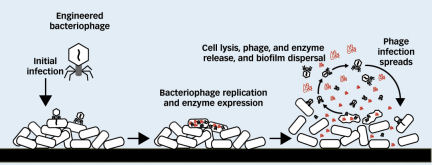- More than 2 years ago
Think of a bacteriophage—a bacteria-attacking virus—as a behind-the-lines saboteur. Scientists have now engineered bacteriophages that can penetrate and dissolve the dense films, such as dental plaque, that some bacterial colonies form. These phages, which produce enzymes that target the so-called biofilms, may offer a new way to circumvent antibiotic resistance in bacteria.

Despite being single-celled organisms, bacteria have social skills. Once they sense each other’s presence through chemical signals, bacteria of one or more species collectively build their biofilms from polymers that they excrete.
James Collins, a biophysicist at Boston University, says that up to 60 percent of bacteria live in biofilms, which have been described as the coral reefs of microbiology (SN: 7/14/01, p. 28). Dental plaque may be the most familiar form, but biofilms can also form on medical devices such as implants and catheters. The films line water pipes and the lungs of cystic fibrosis patients, where they cause potentially lethal infections. Unfortunately, Collins says, the cooperative advantages of living in a biofilm enable the bugs to withstand the action of antibiotics far more effectively than free-swimming bacteria can. To fight biofilms, “the challenge is to penetrate the matrix,” Collins says.
With Tim Lu of Harvard University and the Massachusetts Institute of Technology, Collins has now devised a two-pronged biowarfare strategy against biofilms. First, the scientists experimented with various enzymes to find one that could break down the polymers produced by a specific strain of Escherichia coli. The best enzyme they discovered is called dispersin B. They then genetically engineered a bacteriophage—which looks like a miniature Apollo lunar-landing module—by inserting the gene for the enzyme into the virus’ DNA.
Next, the scientists dropped the phage onto an E. coli biofilm. After the viruses made their way into some of the bacteria, they hijacked the bacteria’s cellular machinery and started making more phage copies as well as the enzyme.
As an overpopulation of phages caused bacterial cells to swell and burst, the viruses spread to infect more bacteria, while the released enzyme dissolved the biofilm’s polymer matrix. The biofilm virtually disappeared within 2 days, the authors report in the July 3 Proceedings of the National Academy of Sciences.
Collins and Lu assert that their method gets better results than do earlier strategies that focused on either killing the bacteria or dissolving the film.
Philip Stewart of the Center for Biofilm Engineering at Montana State University in Bozeman says that Collins and Lu were “clever” in coming up with the two-pronged attack. “You’re not only killing cells, which is the old way of thinking,” he says. “You’re also weakening the biofilm mechanically.”
The challenge, Stewart says, will be to compile a toolbox of many enzymes that scientists and ultimately doctors can use to target various biofilms.





